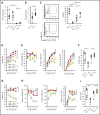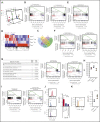Prolonged maintenance of hematopoietic stem cells that escape from thrombopoietin deprivation
- PMID: 33657206
- PMCID: PMC9635515
- DOI: 10.1182/blood.2020005517
Prolonged maintenance of hematopoietic stem cells that escape from thrombopoietin deprivation
Abstract
Hematopoietic stem cells (HSC) rarely divide, rest in quiescence, and proliferate only upon stress hematopoiesis. The cytokine thrombopoietin (Thpo) has been perplexingly described to induce quiescence and promote self-renewal divisions in HSCs. To clarify the contradictory effect of Thpo, we conducted a detailed analysis on conventional (Thpo-/-) and liver-specific (Thpofl/fl;AlbCre+/-) Thpo-deletion models. Thpo-/- HSCs exhibited profound loss of quiescence, impaired cell cycle progression, and increased apoptosis. Thpo-/- HSCs also exhibited diminished mitochondrial mass and impaired mitochondrial bioenergetics. Abnormal HSC phenotypes in Thpo-/- mice were reversible after HSC transplantation into wild-type recipients. Moreover, Thpo-/- HSCs acquired quiescence with extended administration of a Thpo receptor agonist, romiplostim, and were prone to subsequent stem cell exhaustion during competitive bone marrow transplantation. Thpofl/fl;AlbCre+/- HSCs exhibited similar stem cell phenotypes but to a lesser degree compared with Thpo-/- HSCs. HSCs that survive Thpo deficiency acquire quiescence in a dose-dependent manner through the modification of their metabolic state.
© 2021 by The American Society of Hematology.
Figures







Similar articles
-
[Thrombopoietin regulates mitochondria homeostasis for hematopoietic stem cell maintenance].Rinsho Ketsueki. 2021;62(5):521-527. doi: 10.11406/rinketsu.62.521. Rinsho Ketsueki. 2021. PMID: 34248130 Review. Japanese.
-
Critical role of thrombopoietin in maintaining adult quiescent hematopoietic stem cells.Cell Stem Cell. 2007 Dec 13;1(6):671-84. doi: 10.1016/j.stem.2007.10.008. Epub 2007 Nov 20. Cell Stem Cell. 2007. PMID: 18371408
-
Thrombopoietin/MPL signaling regulates hematopoietic stem cell quiescence and interaction with the osteoblastic niche.Cell Stem Cell. 2007 Dec 13;1(6):685-97. doi: 10.1016/j.stem.2007.10.020. Epub 2007 Nov 20. Cell Stem Cell. 2007. PMID: 18371409
-
Thrombopoietin from hepatocytes promotes hematopoietic stem cell regeneration after myeloablation.Elife. 2021 Aug 31;10:e69894. doi: 10.7554/eLife.69894. Elife. 2021. PMID: 34463253 Free PMC article.
-
Multifaceted roles of thrombopoietin in hematopoietic stem cell regulation.Ann N Y Acad Sci. 2020 Apr;1466(1):51-58. doi: 10.1111/nyas.14169. Epub 2019 Jul 10. Ann N Y Acad Sci. 2020. PMID: 31292976 Review.
Cited by
-
Exploring the potential of predicted miRNAs on the genes involved in the expansion of hematopoietic stem cells.Sci Rep. 2024 Jul 5;14(1):15551. doi: 10.1038/s41598-024-66614-9. Sci Rep. 2024. PMID: 38969714 Free PMC article.
-
Continuous map of early hematopoietic stem cell differentiation across human lifetime.Nat Commun. 2025 Mar 7;16(1):2287. doi: 10.1038/s41467-025-57096-y. Nat Commun. 2025. PMID: 40055319 Free PMC article.
References
-
- Wilson A, Laurenti E, Oser G, et al. Hematopoietic stem cells reversibly switch from dormancy to self-renewal during homeostasis and repair. Cell. 2008;135(6):1118-1129. - PubMed
-
- Walter D, Lier A, Geiselhart A, et al. Exit from dormancy provokes DNA-damage-induced attrition in haematopoietic stem cells. Nature. 2015;520(7548):549-552. - PubMed
-
- Nakamura-Ishizu A, Takizawa H, Suda T. The analysis, roles and regulation of quiescence in hematopoietic stem cells. Development. 2014;141(24):4656-4666. - PubMed
Publication types
MeSH terms
Substances
LinkOut - more resources
Full Text Sources
Other Literature Sources
Medical
Molecular Biology Databases

